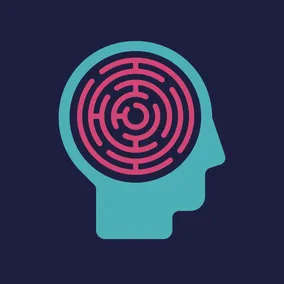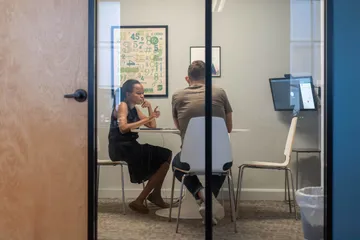How to Be a Problem Finder

Natalie Reich, Former Brand Strategist
Article Category:
Posted on
Being a good consultant isn't just about knowing how to fix problems, it's about being good at figuring out what the problems really are.
Working in consulting means that organizations hire you to solve their problems. You’re “the expert.” You know exactly what to do when parachuted into an unfamiliar business environment and are entrusted with creating something great. You can help. You WILL help.
But first, to solve problems, you need to know what those problems are. This should be easy, right? Just ask the people who hired you! They know their business better than you ever could, and after all, they wouldn’t have hired you if they didn’t know what needed fixing.
Unfortunately, this is not the case (most of the time). Your clients might know their business, but they probably hired you because they only know the extent of their problems insofar as they know those problems exist.
When it comes to the web, more than likely, problems have come to your clients’ attention because of some kind of suboptimal customer or visitor behavior. Those users are either not doing what your clients want them to do, or aren’t having an enjoyable experience while doing it. These problems can be technical (e.g., “people are having a hard time completing our checkout flow”) or communication-based (e.g., “people don’t seem to understand what we do as an organization”). Problems like these can make themselves known in any number of ways, but usually a consultant is called in once they manifest in lower-than-expected revenue.
These technical or communication problems can seem easy to identify on a surface level, but the trick to coming up with the best possible solutions is to get to the deeper problems the organization itself is dealing with — the ones that caused the more surface-level, symptomatic problems to begin with. Part of your job, perhaps the most important part of your job, is to correctly identify those problems.
Here’s the real real when it comes to solving problems: your job as a consultant isn’t to be a mathematician. It’s to be a detective. And maybe a therapist.

Here’s how you do it:
1. Set the stage for openness and honesty
This could probably be listed as Step 0, because it’s basically the water in which all the other steps swim. Communicate to the team that you are a neutral third party, that you are creating a “safe space” to share thoughts in, and that you are ultimately only there to help.
It’s also important to let people communicate their ideas in an independent format, before/without hearing what other people say first; otherwise the loudest voice in the room often dominates and influences what others say. This can be as easy as giving everyone a stack of sticky notes to write ideas onto and then collecting and reading them without naming or calling anyone out for what they wrote.
2. Listen (and write everything down)
Genuine, empathetic listening should be at the core of any consultant-client relationship from beginning to end. You’re not listening in order to hear what the problems are and take them as gospel (as stated above, your client might not even know what they are), your aim here is to hear people out.
The more you listen, and the more people you listen to, the better you’ll become at reading between the lines and beginning to uncover the underlying problems. Look out for things you hear multiple times from multiple people. This isn’t just about formal stakeholder interviews, either. Anytime someone (whether the client or a user) starts to speak freely about their problems, it’s an opportunity to learn and get closer to the truth.
3. Ask the right questions
This is about both building trust with the client and beginning to tease out the surface problems from the stickier, fundamental issues that are coming between your client and the outcome they’re hoping for. The good news is, coming up with the right questions results directly from listening.
There’s no fixed menu for what constitutes “right” questions at this phase — sometimes it’s as simple as asking the same question in different ways. Regardless, the questions will depend on the client’s unique situation. It’s about getting as much information as you can from every possible angle and gaining an understanding of why the client sought you out in the first place.
4. Ask more questions
This is when you start really embracing your new role as detective/therapist. If you’re sensing a theme here, it’s “don’t take what you hear at face value.” You need to probe beyond the surface responses and answers you’re likely to get when you first meet and start talking to clients and users.
Digging deeper in your questioning also gets easier once you’ve built up trust, since that’s when things can get a bit touchy, especially if what’s at the heart of their problems is something having to do with the organization’s very reason for being. Again, there are no set questions at this phase, though asking a lot of “why do you think that’s the case?” questions is always good.
5. Restate what you’ve learned back to the client
Making sure that the things you’ve heard, and how you’re interpreting them, are accurate is critical to having everyone on the same page while you concept solutions. This is also when your therapy skills might come in handy again. Laying out all of the organization’s issues can be uncomfortable.
You might find, when restating your findings back to the client, that a whole new can of worms opens up. Reaffirm your “neutral third party” status when uncovering potentially controversial topics, acknowledge them as such, and explain why it’s important to recognize what’s really up even if it might piss people off. Also: don’t be afraid to piss people off (while always remaining diplomatic). Deep problems are often entrenched in the organization, which is the reason they’re buried under other stuff and are therefore the hardest to identify and fix.
Clearly, disagreements and roadblocks are frustrating. It can be tempting to just settle on a list of problems that seem “good enough” and plow ahead. Don’t do it! If you do, your solutions will be superficial at best, and counterproductive at worst. The underlying issues will still be there — unsaid and unresolved and still affecting everything else.
Repeat steps 1 - 5 until all involved agree that you’ve correctly identified the organization’s core problems and you are given the green light to move forward. With consensus on what you’re really there to do, you can confidently begin the hard work of strategically addressing problems by creating solutions that are both practical and imaginative. No pressure!